Creator speaks
Lutz Karl Vieweg talks about the development of Evil Garden:
“In 1988, I was still “under age” and going to school. To earn some money, I was working in a computer repair shop a few hours per week – back then, if a computer was broken, it was repaired rather than thrown away, and de-soldering a chip, then replacing it with a working one could be done often for a few bucks, so at a tiny fraction of the price of a new computer. Who doesn’t remember the infamous MOS 6526 chips failing when somebody played too badly with the ports? At the same time, I was also an enthusiastic assembler programmer on the C64, C128 and later the Amiga.
At that time, some friends of mine had established a business relationship to “Demonware”, a rather small video game company which was led by people only slightly older than we were, and certainly not a well organized one. But they were kind of fun to deal with – and they resided in the same house that also hosted the studio where the first “Snap!” songs were recorded – so we certainly heard them long before they became famous! ;-)
Demonware wanted another Amiga game – the successful Amiga 500 was pretty new by then, while the C64 was in extremely widespread use and certainly “aged” to the point where it wasn’t the hippest game machine anymore. Demonware wanted a game based on the ancient arcade game “Centipede”, they had even bought an old Centipede arcade machine for inspiration which was later raffled to Evil Garden buyers (or so they said, I have no idea whether the arcade machine actually went to some legit “lucky winner”).
Soon after the implementation of the Amiga version had started, we talked about the possibility of also doing a C64 version, I agreed to do all the C64 programming on my own, only needing help from a musician and an “artwork” guy to paint the graphics. A fixed price was agreed upon – a mode not unusual back then. And while the high 4-digit-Deutsche-Mark-figure was good money for me back then, this is certainly nothing comparable to budgets of 21st century computer games.
The music for the C64 version of Evil Garden was composed by Dennis Sarratou, he is still into music today – see https://www.discogs.com/artist/428945-Dennis-Pierre-Sarratou – back then, creating music for a computer game did not mean “use arbitrary equipment, record a vorbis file and be done”, instead, one had to “program” the music, and while existing “tracker software” on the C64 itself could help with the 3 analog tracks, the 4-bit-digitized percussion sounds where both sampled in lengthy sessions with a microphone, and the my development task included the writing of the software to arrange and replay those sounds as part of the game development. (Technical detail: The 4-bit digitized sound is replayed by periodically triggering the NMI – the “non-maskable interrupt” – and setting the “output volume” of the SID on each NMI occurence.)
The graphics (except for the fonts, which I did myself) for the C64 were mostly done by Joachim Rosenögger, who later didn’t pursue a career as artist, last time I checked he was working for Microsoft hunting software pirates.
Evil Garden was supposed to go beyond the rather simple “Centipede” gameplay in that it was intended to support two simultaneous players and multiple, different weapons. But for the C64 implementation, I thought that this was still “too close to just doing a Centipede clone”, I wanted some unusual new elements in the gameplay. Looking back, I see that since this was before the time I was drafted to the German army, I probably had an overly optimistic idea about average “gamers” acceptance of unusual ideas :-) – some of the gameplay ideas I put into the C64 version of Evil Garden were:
– There is a “clock” ticking, indicating the time of the day (but progressing faster than Realtime). If you are still fighting in a level “at the time it gets dark”, then you have to actually fight in the dark, lit only by two small headlights on your player and the occasional explosion flashes.
– In between levels, you can opt to “camp and take a rest”, so you can avoid the dark hours of the day, and replenish your ammunition in exchange for the points/money you earned. So just playing on without a pause will get you in trouble, when you ammunition is spent, it’s gone, and you’re “worm food”. Of course, if you spend all your money on ammunition, that lowers your total score – kind of like in real life :-)
– If you want to enter yourself into the high-score list, you have to voluntarily leave the game while you are still alive! That was only plausible to me: You are hired as a mercenary to fight the monsters of Evil Garden, and if they get to eat you, it doesn’t matter how much money you were promised for the job – you’re dead, so you cannot spend the money!
The implementation of Evil Garden C64 progressed nicely as planned – the only idea I had to drop was the originally planned support for track balls – it turned out that the only C64 trackballs on the market were just unusable junk. Getting the motion of the “worm” right turned out to be non-trivial, but when successfully done, the algorithm was also applied to the Amiga version, which suffered from a very poor behaviour of the “worm” in the beginning.
Technical notes: The “worm” and the “mushrooms” are all custom-font character-set graphics, the animation of the worm details is done by cycling through different but similar character sets. The players, shots and “special monsters” are sprites, but of course it took a lot of raster-line-based interrupt programming magic to multiplex the sprites such that way more than 8 objects could be animated at a time. The drawing of the screen graphics is otherwise, of course, synchronized with the vertical blanking interrupt. Up until today it is beyond me how people can accept games where the image is distorted by switching images while the display is only partially refreshed…
As you certainly already know, my unusual gameplay ideas were never put to the test, as Evil Garden was never published for the C64. The reason wasn’t that Demonware was not satisfied – on the contrary, I got a strong thumbs-up by the Demonware management for my game, I was paid as agreed, as were my colleagues. But back then, publishing a game meant more up-front investments than just uploading the game to some “online app shop”: Floppy disks had to be bought and copied onto, manuals and boxes had to be manufactured, and last but not least, distribution channels demanded the right to hand back all non-sold items for a full refund. So publishing was financially a gamble with stakes higher than the cost for the programming, and at some point Demonware, probably not the most well financed company anyway, decided to not take that gamble, and only tried their luck with the Amiga version.
I do not know whether the Amiga version was commercially a success for Demonware, but given that another project was begun after “Evil Garden” was finished, I suppose that at least nobody had hard feelings about Evil Garden. That next project didn’t end well though, it was called off, probably because Demonware was on the brink of a financial meltdown, and the person in charge disappeared – with invoices from us unpaid. “Demonware” was officially erased from the company register in 1996 – but was probably non-operational at that time for years already.
I continued to pursue software programming – but preferred to implement tools and “serious” software rather than games. During my involuntary year in the army I published shareware for the HP 48, later worked on contracts for Amiga and HP-UX software, graduated in Physics and hired at a tiny company which first sold tools for C++ programmers and then developed software-as-a-service for financial data. That company grew and survived the end of the first “Internet bubble”, it merged and was bought multiple times. (And btw., at a time one colleague of mine there was the author of the C64 “Space Pilot” game :-)
While I do like to think back about software development in the 1980’s, when a sub-1MHz-CPU with 64k RAM did everything required for an entertaining game, I am not really nostalgic about computers – I rarely do “retro gaming”. I did recently play “Nuclear War” in a web-browser from archive.org, though, that’s one of the few “retro games” I would like to see a new version of. I still like computer games when they are well done and playable “offline” – e.g. I played through the whole of GTA V.
I’m surprised there is still interest in the old C64 games, and since there is, it is probably worthwhile to finally make a public release of Evil Garden, so here it is. Don’t be surprised that I used my middle name, Karl, in the opening titles – I have learned early that non-German-speakers just cannot pronounce “Lutz” correctly, that’s the whole reason.
One more technical note: When starting Evil Garden in an emulator, better press “n” when asked whether to use the “fast loader”, as that fast loader is not compatible with every C64 emulator. The first opening title is aborted by pressing “run/stop” and “q” simultaneously, the second title with the static image and the music (which you should listen to completely once – it’s really good!) can be aborted by pressing space.
Notice that you will probably need to have the scanned paper manual and the images of the box at hand when the software asks its “copy protection questions”. And yes, there was only the Amiga version of the box, showing Amiga screen shots on the backside. No C64 box was produced.
Enjoy,
Lutz Karl Vieweg”
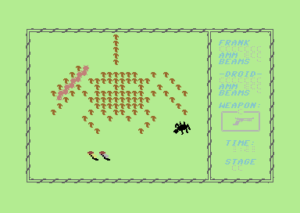
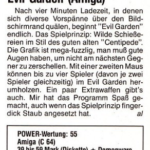
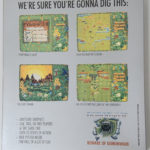
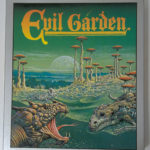
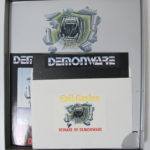
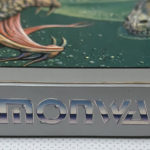

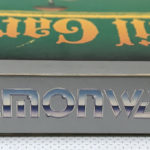
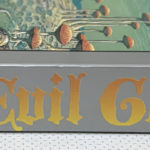
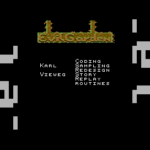
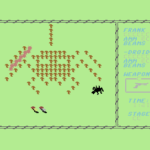
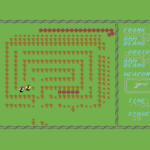

Hehehe… how STRANGE is this game! :-D
A great find Frank. Well done!